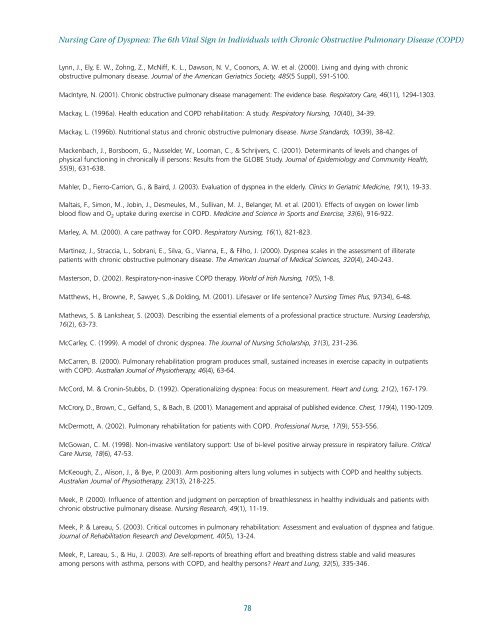Nursing Care of Dyspnea: The 6th Vital Sign in Individuals with ...
Nursing Care of Dyspnea: The 6th Vital Sign in Individuals with ...
Nursing Care of Dyspnea: The 6th Vital Sign in Individuals with ...
You also want an ePaper? Increase the reach of your titles
YUMPU automatically turns print PDFs into web optimized ePapers that Google loves.
<strong>Nurs<strong>in</strong>g</strong> <strong>Care</strong> <strong>of</strong> <strong>Dyspnea</strong>: <strong>The</strong> <strong>6th</strong> <strong>Vital</strong> <strong>Sign</strong> <strong>in</strong> <strong>Individuals</strong> <strong>with</strong> Chronic Obstructive Pulmonary Disease (COPD)Lynn, J., Ely, E. W., Zohng, Z., McNiff, K. L., Dawson, N. V., Coonors, A. W. et al. (2000). Liv<strong>in</strong>g and dy<strong>in</strong>g <strong>with</strong> chronicobstructive pulmonary disease. Journal <strong>of</strong> the American Geriatrics Society, 48S(5 Suppl), S91-S100.MacIntyre, N. (2001). Chronic obstructive pulmonary disease management: <strong>The</strong> evidence base. Respiratory <strong>Care</strong>, 46(11), 1294-1303.Mackay, L. (1996a). Health education and COPD rehabilitation: A study. Respiratory <strong>Nurs<strong>in</strong>g</strong>, 10(40), 34-39.Mackay, L. (1996b). Nutritional status and chronic obstructive pulmonary disease. Nurse Standards, 10(39), 38-42.Mackenbach, J., Borsboom, G., Nusselder, W., Looman, C., & Schrijvers, C. (2001). Determ<strong>in</strong>ants <strong>of</strong> levels and changes <strong>of</strong>physical function<strong>in</strong>g <strong>in</strong> chronically ill persons: Results from the GLOBE Study. Journal <strong>of</strong> Epidemiology and Community Health,55(9), 631-638.Mahler, D., Fierro-Carrion, G., & Baird, J. (2003). Evaluation <strong>of</strong> dyspnea <strong>in</strong> the elderly. Cl<strong>in</strong>ics In Geriatric Medic<strong>in</strong>e, 19(1), 19-33.Maltais, F., Simon, M., Job<strong>in</strong>, J., Desmeules, M., Sullivan, M. J., Belanger, M. et al. (2001). Effects <strong>of</strong> oxygen on lower limbblood flow and O 2 uptake dur<strong>in</strong>g exercise <strong>in</strong> COPD. Medic<strong>in</strong>e and Science <strong>in</strong> Sports and Exercise, 33(6), 916-922.Marley, A. M. (2000). A care pathway for COPD. Respiratory <strong>Nurs<strong>in</strong>g</strong>, 16(1), 821-823.Mart<strong>in</strong>ez, J., Straccia, L., Sobrani, E., Silva, G., Vianna, E., & Filho, J. (2000). <strong>Dyspnea</strong> scales <strong>in</strong> the assessment <strong>of</strong> illiteratepatients <strong>with</strong> chronic obstructive pulmonary disease. <strong>The</strong> American Journal <strong>of</strong> Medical Sciences, 320(4), 240-243.Masterson, D. (2002). Respiratory-non-<strong>in</strong>asive COPD therapy. World <strong>of</strong> Irish <strong>Nurs<strong>in</strong>g</strong>, 10(5), 1-8.Matthews, H., Browne, P., Sawyer, S.,& Dold<strong>in</strong>g, M. (2001). Lifesaver or life sentence? <strong>Nurs<strong>in</strong>g</strong> Times Plus, 97(34), 6-48.Mathews, S. & Lankshear, S. (2003). Describ<strong>in</strong>g the essential elements <strong>of</strong> a pr<strong>of</strong>essional practice structure. <strong>Nurs<strong>in</strong>g</strong> Leadership,16(2), 63-73.McCarley, C. (1999). A model <strong>of</strong> chronic dyspnea. <strong>The</strong> Journal <strong>of</strong> <strong>Nurs<strong>in</strong>g</strong> Scholarship, 31(3), 231-236.McCarren, B. (2000). Pulmonary rehabilitation program produces small, susta<strong>in</strong>ed <strong>in</strong>creases <strong>in</strong> exercise capacity <strong>in</strong> outpatients<strong>with</strong> COPD. Australian Journal <strong>of</strong> Physiotherapy, 46(4), 63-64.McCord, M. & Cron<strong>in</strong>-Stubbs, D. (1992). Operationaliz<strong>in</strong>g dyspnea: Focus on measurement. Heart and Lung, 21(2), 167-179.McCrory, D., Brown, C., Gelfand, S., & Bach, B. (2001). Management and appraisal <strong>of</strong> published evidence. Chest, 119(4), 1190-1209.McDermott, A. (2002). Pulmonary rehabilitation for patients <strong>with</strong> COPD. Pr<strong>of</strong>essional Nurse, 17(9), 553-556.McGowan, C. M. (1998). Non-<strong>in</strong>vasive ventilatory support: Use <strong>of</strong> bi-level positive airway pressure <strong>in</strong> respiratory failure. Critical<strong>Care</strong> Nurse, 18(6), 47-53.McKeough, Z., Alison, J., & Bye, P. (2003). Arm position<strong>in</strong>g alters lung volumes <strong>in</strong> subjects <strong>with</strong> COPD and healthy subjects.Australian Journal <strong>of</strong> Physiotherapy, 23(13), 218-225.Meek, P. (2000). Influence <strong>of</strong> attention and judgment on perception <strong>of</strong> breathlessness <strong>in</strong> healthy <strong>in</strong>dividuals and patients <strong>with</strong>chronic obstructive pulmonary disease. <strong>Nurs<strong>in</strong>g</strong> Research, 49(1), 11-19.Meek, P. & Lareau, S. (2003). Critical outcomes <strong>in</strong> pulmonary rehabilitation: Assessment and evaluation <strong>of</strong> dyspnea and fatigue.Journal <strong>of</strong> Rehabilitation Research and Development, 40(5), 13-24.Meek, P., Lareau, S., & Hu, J. (2003). Are self-reports <strong>of</strong> breath<strong>in</strong>g effort and breath<strong>in</strong>g distress stable and valid measuresamong persons <strong>with</strong> asthma, persons <strong>with</strong> COPD, and healthy persons? Heart and Lung, 32(5), 335-346.78
















